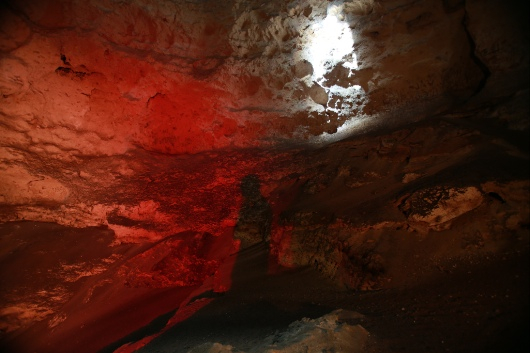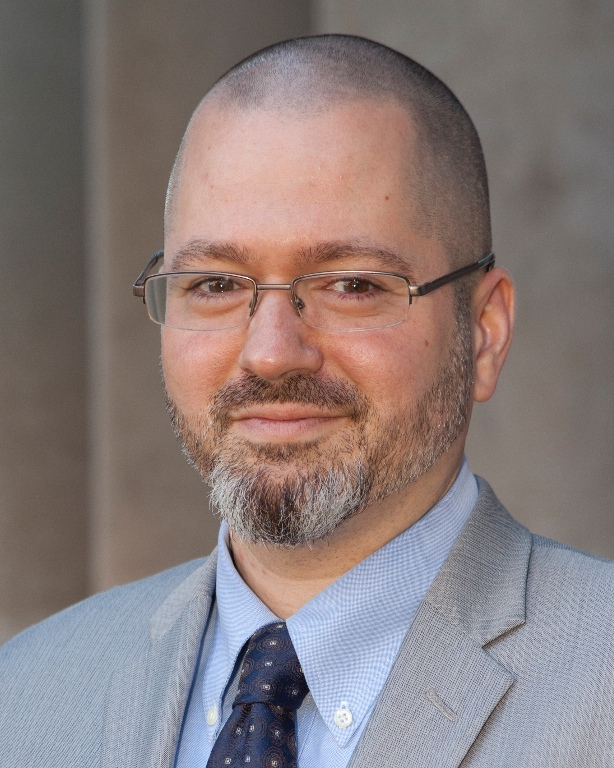Puerto Rican Artists Shine Light on American Carnage
For two years Puerto Rico was illuminated from within
By Spencer DewMay 10, 2018
 For two years Puerto Rico was illuminated from within. A curious work of art, located deep inside a limestone cave, deserved to be considered “religious” for multiple reasons. Reframing a remote rock formation rich with traces of indigenous history and myth, this work was the object of visits resembling nothing so much as pilgrimage. For some, it sacralized the space in which it was placed. Most importantly, however, Allora & Calzadilla’s Puerto Rican Light (Cueva Vientos) functioned as a source of immanent critique. The artwork occasioned critical reflection on power relations, on the legacy and continuing process of colonialism—reflections linked to nature and industry, resources and electricity, that are particularly timely for Puerto Rico today.
For two years Puerto Rico was illuminated from within. A curious work of art, located deep inside a limestone cave, deserved to be considered “religious” for multiple reasons. Reframing a remote rock formation rich with traces of indigenous history and myth, this work was the object of visits resembling nothing so much as pilgrimage. For some, it sacralized the space in which it was placed. Most importantly, however, Allora & Calzadilla’s Puerto Rican Light (Cueva Vientos) functioned as a source of immanent critique. The artwork occasioned critical reflection on power relations, on the legacy and continuing process of colonialism—reflections linked to nature and industry, resources and electricity, that are particularly timely for Puerto Rico today.
Materially, the piece consisted of three famous fluorescent tubes—artist Dan Flavin’s 1965 sculpture Puerto Rican Light (to Jeanie Blake)—recontextualized by two Puerto Rican artists in the Cueva Vientos cave in Puerto Rico’s El Convento Natural Protected Area. The tubes were housed in a hermetic, climate-controlled chamber powered by solar cells. For those who saw it, the piece prompted reconsideration of light and space, turning the cave and its surrounding forest into a kind of cathedral, the natural intervened upon by something almost supernatural, its luminosity accompanied by a faint hum.
Conceptually, the piece referenced the ravages of colonialism, the obsolescence of industry, the crisis implicit in fossil fuel energy use, as well as the promise of self-sufficiency. In Allora & Calzadilla’s work history stands as both tragedy and source of hope, just as the piece itself depended upon the ancient and the futuristic.
Flavin—whose minimalist, fluorescent tube sculptures became famous in the 1960s—named his Puerto Rican Light (to Jeanie Blake) after the colors of New York’s Puerto Rican Day parade. Framed by that title, the work suggests the sliding scale of tropical/primitive/feminine expounded by colonizers and travel agents alike, while the use of fluorescent tubes, as Yasmin Ramirez argues, emphasizes a sense of the industrial, replicating a mainland sentiment wherein Puerto Rico is simultaneously a tourist paradise and an outpost of the military-industrial complex. Allora & Calzadilla refuted such readings and reclaimed the piece both for the bright electricity-generating light of Puerto Rico and the darkness of a bat-lined cave the native Taíno people associated with the land of the dead.
Indeed, to visit the piece, one had to travel through dead lands. The scenery offered a history lesson, moving through the polluting wrecks of petroleum refineries past abandoned sugar-processing facilities, backwards from the industrial age to chattel slavery. A tour of “American carnage,” some might say, but the real catastrophe here is an economic and political system that profits from debt.
It is not only the metropole that has grown rich exploiting people the Supreme Court ruled “unfit” for self-government; the colonized population, in turn, has stratified and fed off its own people. A current example is the Puerto Rico Electric Power Authority (PREPA) brokering a deal with private companies for the repair of the island’s electrical grid rather than relying on mutual aid agreements with mainland power companies. The debt accrued—an absurd $945 million—is unpayable. The deal thus smacks of the same predatory investment practices that led to the brittle and out-of-date infrastructure so damaged by Hurricane Maria. Not only has the company contracted by PREPA failed to restore power to tens of thousands of citizens more than seven months after Maria, but it has also been responsible for several major blackouts across the island in recent weeks. These blackouts shed light on the continuing exploitation of Puerto Rico by vulture hedge funds cashing in on increasing Puerto Rican debt.
While Allora & Calzadilla’s installation predated the hurricane, the deeper storm of financial insecurity has been long-brewing. In interviews the artists spoke explicitly of PREPA’s debt and the tenuousness of electrical power on an island rich in the natural resource of sunlight. By powering their artwork with the sun, the artists demonstrated the possibility of local, sustainable power. Far more than three small, glowing tubes within a massive cave, Allora & Calzadilla’s work was, and remains, a symbol—needed now more than ever—of a Puerto Rico capable of making its own light, of existing independent from the tyrannous control of profiteering juntas in D.C. or San Juan.
That, perhaps, is the most breathtaking element of this audacious creation: beyond the majesty of nature and the mystery of Puerto Rican Light (Cueva Vientos)’s electrical glow, the piece offered a counter-reality, a dream of community in contrast to the exploitation of colonial power—another form of power altogether, grounded in the earth.
Resources
- Aronoff, Kate. “Controversial Contractor Was Behind Island-Wide Blackout, as Puerto Rico Debates Full Privatization.” The Intercept. April 23, 2018.
- Beder, Sharon. “Who’s Got the Power?” In Puerto Rican Light (Cueva Vientos) (Dia Art Foundation, 2016): 115-124.
- Expósito, Frank. “Interviews: Allora & Calzadilla.” Artforum. September 22, 2015.
- Gotthardt, Alexxa. “Why a Dan Flavin Work Hidden in a Puerto Rican Cave Makes a Timely Political Statement.” Artsy. June 5, 2017.
- Irfan, Umair. “The entire island of Puerto Rico just lost power. Again.” Vox. April 19, 2018.
- McKee, Yates. “Cave Art and Climate Debt: The Geopolitics of Puerto Rican Light.” Puerto Rican Light (Cueva Vientos) (Dia Art Foundation, 2016): 29-45.
- Ramirez, Yasmin “Puerto Rican Light (to Allora & Calzadilla).” In Sophia Hernandez Cuy, ed., Puerto Rican Light (The Americas Society, 2005): 49-58.
- Summers, Lawrence H. “How to actually help Puerto Rico.” The Washington Post. April 17, 2018.
- Torruella, Juan R. “The Insular Cases: The Establishment of a Regime of Politcal Apartheid.” University of Pennsylvania Journal of International Law, Vol. 29, Issue 2 (2007): 283-347.
- Wagner, James, and Frances Robles. “Puerto Rico Is Once Again Hit by an Islandwide Blackout.” The New York Times. April 18, 2018.
Image: Allora & Calzadilla, Puerto Rican Light (Cueva Vientos), 2015. Guayanilla-Peñuelas, Puerto Rico. (c) Allora & Calzadilla. Courtesy the artist, Dia Art Foundation, and Gladstone Gallery, New York and Brussels | Photo: Myritza Castillo
 Author, Spencer Dew (PhD’09), is an associate professor in the Department of Religious Studies at Centenary College of Louisiana. He is the author of Learning for Revolution: The Work of Kathy Acker (Hyperbole, 2011) and a forthcoming book on law, citizenship, and race in religious movements indebted to the thought of Noble Drew Ali—the Moorish Science Temple of America, Nuwaubian Yamassee, and Washitaw de Dugdahmoundyah—which will be published by the University of Chicago Press. Author, Spencer Dew (PhD’09), is an associate professor in the Department of Religious Studies at Centenary College of Louisiana. He is the author of Learning for Revolution: The Work of Kathy Acker (Hyperbole, 2011) and a forthcoming book on law, citizenship, and race in religious movements indebted to the thought of Noble Drew Ali—the Moorish Science Temple of America, Nuwaubian Yamassee, and Washitaw de Dugdahmoundyah—which will be published by the University of Chicago Press. |
Sightings is edited by Brett Colasacco (AB’07, MDiv’10), a PhD candidate in Religion, Literature, and Visual Culture at the University of Chicago Divinity School. Sign up here to receive Sightings via email. You can also follow us on Facebook and Twitter.

